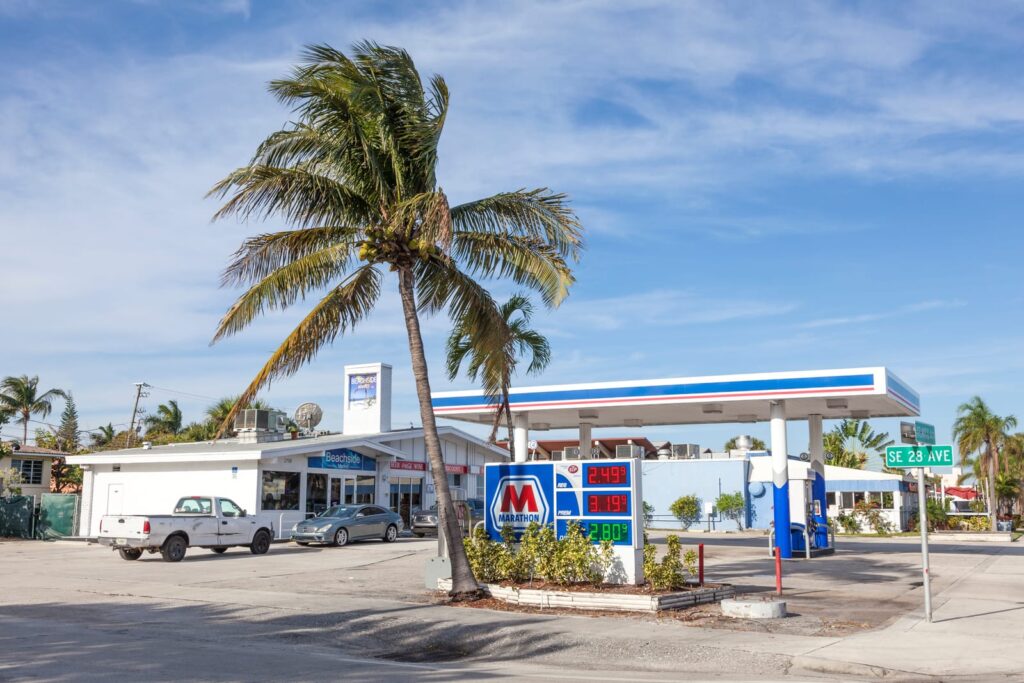Yes, gas station cappuccinos do contain caffeine, typically ranging from 64 to 100 milligrams per 8-ounce serving. The amount varies based on the brand, ingredients, and how the drink is made. Most gas station cappuccinos use instant coffee powder, which tends to have lower caffeine content than regular brewed coffee to save costs.
Understanding what goes into your gas station cappuccino helps you make better choices about your caffeine hit for a road trip. You’ll see how these drinks compare to coffee shop alternatives, what affects their caffeine levels, and whether they’re worth your money for both taste and energy. (hint – not usually, but convenient if no other real choice!)
Typical Ingredients in Gas Station Cappuccinos
Gas station cappuccinos are made from different ingredients than traditional coffee shop versions. Most use instant coffee powder or coffee concentrate as the base ingredient.
The main components include:
- Instant coffee or espresso powder
- Powdered milk or creamer
- Sugar or artificial sweeteners
- Artificial flavoring agents
Many gas stations use automated machines that mix these powdered ingredients with hot water. Some locations offer liquid concentrates instead of powder.
The coffee component comes from either Arabica or Robusta beans, or even a blend of the two. Robusta beans contain around twice the caffeine of Arabica beans, affecting the final caffeine content.

Presence of Caffeine in Powdered Blends
The caffeine in gas station cappuccino comes directly from the coffee powder or concentrate used in the blend.
Factors that affect caffeine levels include:
- Type of coffee beans used
- Amount of coffee powder per serving
- Brewing strength of the concentrate
- Size of the drink
A 16-ounce serving can contain significantly more caffeine than an 8-ounce cup. The milk powder and other ingredients do not add caffeine to the drink. You probably won’t get double the coffee element, as usually it’s just more of the white stuff.
Different brands use varying amounts of coffee in their blends. This explains why caffeine content can vary greatly between gas stations.
Comparison With Coffee Shop Cappuccino
Gas station cappuccinos typically contain less caffeine than coffee shop versions. Traditional cappuccinos use fresh espresso shots, which provide concentrated caffeine.
Coffee shops use real espresso machines that extract more caffeine from fresh coffee grounds. Gas stations rely on pre-made powders or concentrates.
The preparation method matters. Fresh espresso extraction pulls more caffeine than dissolving instant coffee powder in hot water.
However, some gas stations with high-quality espresso machines can match coffee shop caffeine levels. These locations are less common than standard powder-based systems.
Gas Station Cappuccino Caffeine Content
These drinks typically contain 64-150 mg of caffeine per 8-ounce serving, though this amount varies based on serving size, brand differences, and preparation methods. These levels generally fall below regular black coffee but exceed many other coffee drinks.
Caffeine Content by Serving Size
The standard 8-ounce gas station cappuccino contains between 64-100 mg of caffeine. However, many gas stations offer larger sizes that increase the total caffeine content.
A 12-ounce serving typically provides 96-150 mg of caffeine. The 16-ounce size can deliver up to 200 mg of caffeine, depending on the brand and preparation method.
Differences Among Brands and Machines
Different gas station brands produce cappuccinos with varying caffeine levels. Some chains prioritize stronger coffee flavor, using higher coffee-to-milk ratios.
7-Eleven cappuccinos typically contain 70-90 mg per 8 ounces. Wawa and Sheetz offerings range from 80-120 mg per serving.
Machine types also impact caffeine content. Older powder-based machines often produce weaker drinks with 64-80 mg of caffeine. Newer machines that brew fresh coffee deliver 90-150 mg per serving.
Pre-packaged cappuccino mixes contain standardized caffeine amounts. Fresh-brewed options from newer machines show more variation but generally higher caffeine levels.
Comparison With Black Coffee and Espresso
Gas station cappuccinos contain less caffeine than regular black coffee. An 8-ounce cup of black coffee provides 95-200 mg of caffeine, making it stronger than most cappuccinos.
A single shot of espresso contains 63-75 mg of caffeine. Since cappuccinos traditionally use one espresso shot, gas station versions with 64-100 mg fall within expected ranges.
Gas station cappuccinos offer moderate caffeine levels compared to other coffee drinks. They provide more caffeine than decaf options but less than energy drinks or large black coffees.
The milk content in cappuccinos dilutes the coffee concentration. This reduces caffeine per ounce compared to straight espresso or black coffee.
What Influences Caffeine Levels in Gas Station Machines?
The caffeine content in your gas station cappuccino depends on the type of coffee beans used, how dark they’re roasted, and whether the drink uses real espresso or instant coffee powders.
Coffee Beans: Arabica vs Robusta
The type of coffee beans in your cappuccino makes a big difference in caffeine levels. Robusta beans contain about twice as much caffeine as arabica beans.
Robusta beans have 2.2 to 2.7% caffeine content. Arabica beans only have 1.2 to 1.5% caffeine content.
Most gas stations use cheaper coffee blends. These blends often contain more robusta beans to cut costs. This actually gives you more caffeine than expensive arabica-only blends.
Some gas station brands mix both types. The exact ratio affects your final caffeine intake. You won’t always know which beans your cappuccino contains since gas stations rarely list this information.
Premium gas station chains may use more arabica beans. Budget options typically rely on robusta-heavy blends for stronger caffeine content.
Roast Level Impact
The roast level of coffee beans changes caffeine content, but not in the way most people think. Light roasts actually have slightly more caffeine than dark roasts.
Dark roasting breaks down caffeine molecules. This reduces the total caffeine by about 2-5% compared to light roasts. The difference is small but measurable.
Gas stations usually use medium to dark roasts. These roasts taste less acidic and appeal to more customers. The darker flavor also masks lower-quality beans.
You’ll find the biggest caffeine differences come from bean type, not roast level. A dark roast robusta still has much more caffeine than a light roast arabica.
Brewing and Preparation Method
How your cappuccino gets made has the biggest impact on caffeine levels. Gas stations use three main methods that create very different results.
Fresh espresso machines produce the highest caffeine content. These machines force hot water through ground coffee beans under pressure. A single espresso shot contains about 63mg of caffeine.
Instant coffee powders have less caffeine. Most instant cappuccino mixes contain 30-60mg of caffeine per serving. The processing removes some of the original caffeine content.
Pre-made liquid concentrates fall somewhere in between. These get diluted with hot milk or water when you buy them.
The milk-to-coffee ratio also matters. More milk means less caffeine per ounce of your final drink. Gas station cappuccinos often have more milk than coffee shop versions.

Taste and Experience of Gas Station Cappuccino
Gas station cappuccinos offer a distinct taste profile that differs from coffee shop versions, primarily due to their use of instant coffee powders and artificial flavorings. The texture and overall drinking experience varies widely based on the machine quality and milk preparation methods used.
Role of Steamed Milk and Flavorings
The steamed milk in gas station cappuccinos often comes from powdered milk rather than fresh dairy. This creates a different texture compared to traditional cappuccinos. The milk tends to be less creamy and may have a slightly artificial taste.
Most gas station machines use pre-mixed powders that combine coffee, milk powder, and sweeteners. These powders dissolve in hot water to create the final drink. The steaming process is usually automated and may not produce the same foam quality as manual espresso machines.
Artificial flavorings play a major role in the taste experience. Common flavors include vanilla, hazelnut, and caramel. These flavorings are often quite sweet and can mask the coffee taste.
The temperature consistency varies between machines. Some produce drinks that are too hot while others may be lukewarm. This affects how the flavors blend together.
Consumer Preferences and Reviews
Many people enjoy gas station cappuccinos as a convenient sweet treat rather than a true coffee experience. Reviews often mention the drinks taste more like hot chocolate than traditional cappuccino.
Price is a major factor in consumer satisfaction. Most gas station cappuccinos cost between $1-3, making them much cheaper than coffee shop alternatives.
Convenience ranks high among positive reviews. Customers appreciate the 24-hour availability and quick preparation time. No waiting in line or complex ordering process appeals to busy travelers.
Common complaints include inconsistent flavor, machines being out of order, and drinks being too sweet. Some consumers note the lack of real coffee taste compared to coffee shop versions.
Regular customers often develop preferences for specific gas station chains or particular flavor combinations that work best with each machine type.
Comparing Gas Station Cappuccinos to Other Coffee Drinks
Gas station cappuccinos typically contain 64-100 mg of caffeine per 8-ounce serving, which places them in the middle range compared to other popular coffee drinks. The instant coffee base and milk ratio in these drinks creates a different caffeine profile than traditional espresso-based beverages.
Cappuccino vs Latte
Traditional cappuccinos and lattes both use espresso shots as their base. A regular cappuccino contains about 63-75 mg of caffeine from one espresso shot.
Key differences:
- Traditional: 1 espresso shot + steamed milk + foam
- Gas station: Instant coffee powder + hot water + milk
Lattes contain the same amount of caffeine as cappuccinos when made with one espresso shot. The main difference is the milk-to-coffee ratio. Lattes have more steamed milk and less foam than cappuccinos.
Gas station versions blur these lines. They often taste milder than coffee shop drinks despite having similar caffeine content, due to the machine being less able to replicate a traditional barista made drink.
Cappuccino vs Americano
An Americano contains significantly more caffeine than most cappuccinos. A typical Americano uses 1-2 espresso shots with hot water, giving you 63-150 mg of caffeine per 8-ounce cup.
Gas station cappuccinos fall on the lower end of this range. They usually contain 64-100 mg of caffeine. However, they taste much milder than an Americano.
The difference comes from preparation:
- Americano: Espresso shots + hot water (strong coffee taste)
- Gas station cappuccino: Instant coffee + milk + flavorings (sweeter, milder taste)
You get less coffee flavor intensity with gas station cappuccinos. The milk and added sugars mask the coffee taste even when caffeine levels are similar.
Instant Coffee Drinks at Gas Stations
Most gas station coffee drinks use instant coffee as their base. This includes cappuccinos, mochas, and flavored coffee beverages.
Instant coffee typically contains less caffeine than regular brewed coffee, but still provides a decent energy boost. A typical cup of instant coffee has 62-90 mg of caffeine. Gas stations often use this in their drink mixes to keep costs down while maintaining consistent flavor.
Common gas station instant drinks:
- Cappuccinos: 64-100 mg caffeine
- Flavored coffees: 60-80 mg caffeine
- Hot chocolate with coffee: 30-50 mg caffeine
The caffeine content stays fairly consistent across different instant coffee drinks. The main variables are serving size and how much instant coffee powder gets used in each mix.
These drinks offer convenience but less control over strength compared to fresh-brewed options.